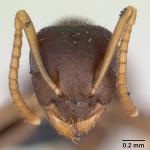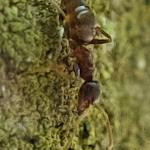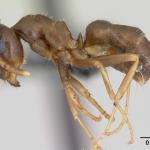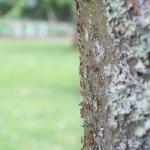Lasius neglectus, the invasive garden ant, is a small brown ant, superficially similar in appearance and behaviour to the common black garden ant Lasius niger (L.). Unlike L. niger, which is monogynous (each nest with a single queen) and has adjacent nests that compete with one another, L. neglectus is polygynous (each nest has many queens) and has adjacent nests that do not compete with each other. This ant probably originated from Asia Minor or Turkey (Seifert, 2000) and is thought to have been introduced into Europe with horticultural materials (Espadaler et al., 2007). It was first identified in Budapest in 1974 (Van Loon, Boomsma & Andrasfalvy, 1990) and since then it has been found in nineteen European countries including France, Germany, Belgium and The Netherlands (Seifert, 2000; Espadaler & Bernal, 2010).
Lasius neglectus was recognised at the National Trust’s Hidcote Manor in Gloucestershire in 2009 and reported by the BBC and other media as "The Asian Super Ant" in August 2009.
Very localised. Colonies are known in Gloucestershire, Cambridgeshire, London, and Yorkshire but could turn up in any suitable habitat.
Workers of L. neglectus may be separated from other Lasius species by the following set of morphological characteristics: maxillary palps relatively long; body brownish; lack of standing hairs on scapes and tibia; mandibles with usually seven sometimes eight teeth; head margin behind eyes with more than 15 standing hairs; clypeus with sparse and relatively long pubescence (similar to L. platythorax Seifert); metanotal groove shallow (well figured by Czechowski, Radchenko & Czechowska, 2002); queens and males noticeably smaller than in other Lasius species. Some of these differences are subtle and wherever possible comparison with reference material, or a second opinion is recommended. Illustrated keys that include L. neglectus are in Czechowski, Radchenko & Czechowska (2002) and Seifert (2007). In older keys such as Skinner & Allen (1996), Bolton & Collingwood (1975) and Brian (1977) L. neglectus will key out as L. alienus Foerster or L. psammophilus Seifert. However the habitat and behaviour of L. neglectus are quite different from either of these species. If dark Lasius are seen in columns openly climbing trees in parks or gardens they are likely to be the common black garden ant L. niger. However if they appear a little smaller, a little paler and the columns more populous and dense than typical columns of L. niger then L. neglectus is a distinct possibility and specimens should be collected for microscopic examination. If using one of the older keys and they key out as L. alienus or L. psammophilus then it is extremely likely that they are L. neglectus.
A useful Lasius neglectus ID sheet is available.
So far have only been found in heavily anthropogenic habitats such as parks and gardens and not in natural habitats.
Swarm flights have not been recorded although both males and winged females are capable of flight.
Nests in the ground, under stones and have also been reported in electric junction boxes.
Often form dense columns climbing tree trunks where they feed on aphid and other sap-sucking-insect honeydew.
2016





